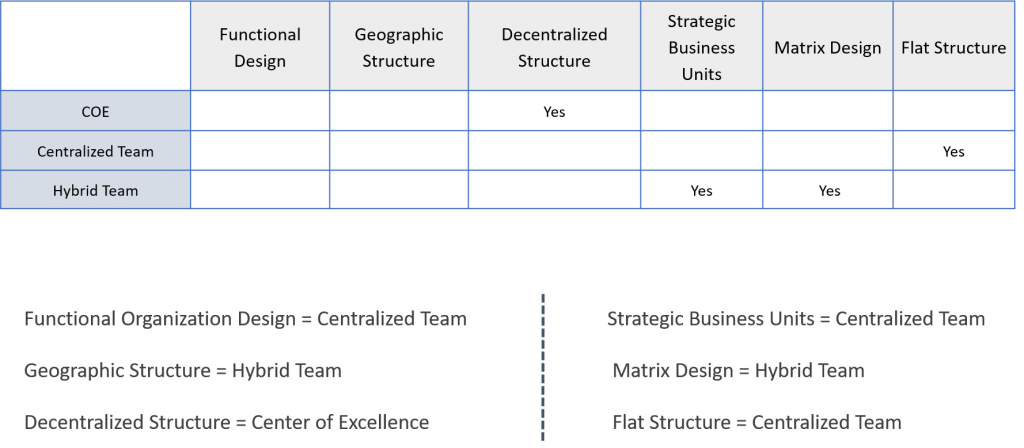In my part 1 of “How to Structure your Digital Marketing Team” article I talked about the four popular team structures. In this article, I will dive deep into different organizational structures.
The goal for any company is to grow–and grow faster, more profitable and more efficient. Yet even after decades of running a company, CEOs and founders often struggle to find the right organization structure to grow their business. Organization structure creates the framework.
6 Popular Organization Structures
Reams of books and articles are written about organization structure, so we will not examine that in this paper. But generally, the lifecycle of a company starts small and then grows to become 100 employees, then 1000, 5,000, and finally to 10,000 employees or more until it becomes an enterprise.
As companies grow into enterprise organizations, complexities arise, not only due to size, but when the company diversifies into different branches of each business area. When you have a situation where the company is playing in multiple product lines, that’s when you create a different organization structure to maximize the business impact on the overall organization.
The Google Case Study on How a Company Goes from Flat Structure to Decentralized Business
One classic case is Google. When Google first started it was merely a search engine. After the search engine grew, the company introduced paid ads. That’s when Google AdWords became a $100B company and began diversifying.
Today, Google owns more than 200 companies such as Google Maps, Google Android, Gmail, Google Classroom,YouTube, and so on.
Over the years Google has diversified in many different product lines. Consequently, the organization structure formed during the first 5 or 10 years of the company’s lifecycle is no longer sustainable. So to set themselves up for future success, Google had to change their organization structure.
6 Business Models For Digital Marketing
Now, let’s discuss 6 of the most common organization structures for business models:
- Functional organizational structure
- Geographic organization structure
- Decentralized business division
- Strategic business unit
- Metric design
- Flat structure
Functional Organizational Structure
A functional organization structure divides divisions by function. Marketing as one function; sales as a function; finance as a function. Each organization function serves a specific function within a company. This model works well when you have a single business line.
Let’s take a software company like Anaplan. Whether It’s a $100M or $500M or a $1B company is of no concern because all the company does is sell one software product. That’s when as functional organization structure applies.
Geographic Organization Structure
In a geographic organization structure, the company offices in multiple countries or continents. And because they’re all structured differently, they operate independently. In this case, the organizational structure is geographic.

Decentralized Business Unit
The decentralized business unit is where each business unit within the big umbrella organization is responsible for its own profit and loss. Each business unit operates independently as its own business division. Classic cases are car companies or many of the Amazon companies.
Strategic Business Unit (SBU)
In the 1980s, Strategic Business Units (SBUs) came into fashion where you had a business as a strategic objective. Essentially, strategic business units were created to meet those strategic business objectives or business goals and SBUs or strategic business units were formed.
Matrix Design
In a matrix design, what usually happens is employees have a matrix reporting structure–that means one person can report to two different business units. For example, a digital marketer may report to Marketing and IT. That kind of matrix design is usually more fully utilized by companies having many different business units and various product lines. That’s when the matrix design of the organization structure is very much in vogue.
Flat Structure
The flat structure is basically for smaller sized companies with 20, 30 or even 40 employees. The company may have a head of sales, head of marketing, head of customer success and head of development who all contribute to the whole and everyone reports directly to the CEO.
These are some descriptions around the different organization structures. Next, we’ll discuss how this impacts your marketing team.
How to Match the Organization Structure with Your Digital Marketing Team
If your digital marketing team is not structured or aligned in terms of the company’s organization structure, chances are you are setting yourself up for failure. As a marketer, When building a marketing team, you have to focus on what kind of team structure works best within your particular company’s organization structure.

Let’s say you work in a company with a decentralized structure. That means each business unit minds its own business; they’re all responsible for their own profit and loss. If you are trying to pitch for an in-house digital marketing team, this is going to be tough.
The reason is the company organizationally is structured to be decentralized. And when you try to create a department which is centralized or totally in-house, this goes against the nature of the culture of the company. So you are setting yourself up for failure.
What Makes Sense for Your Company?
The chart above shows how the structures need to match. For example, if you have one business unit or one product line and that’s how your functional organization is designed, then a centralized team, or an in-house marketing team, makes the most sense.
On the other hand, If you have a geographical organizational structure with offices in multiple countries, then you want to create a hybrid team with in-house team members in different geographic areas.
For example, if you have an office in China, then you want to have a few marketing team members in China. If you have offices in India or Europe, then you want to have some marketing team members sitting in those areas.
In this case, working with the hybrid digital marketing team or setting up a Center of Excellence model are both good options because the structure works well within a geographically-spread organization structure.
Now, a decentralized structure is where the company has 10 different product lines and everyone is responsible for their own profit and loss (classic cases are companies like HP, Dell or even Amazon). For those types of companies when you create a Center of Excellence model team structure, you’re more inclined to succeed.

Conversely, in a flat structure, an in-house team works well. Especially for a smaller company.
In a matrix organization, again, the hybrid structure where you work with an agency but you also have some in-house marketers is a good option.
In a strategic business unit or BU organizational structure, then an in-house team works well.
The chart below shows how to create the best digital marketing team structure that aligns with your organization’s structure. Check the boxes to see how to create your team structure according to a team grid.
The key point is to look at the overarching organizational structure for your company. Then build a digital marketing team that aligns within that structure.
With the right organization structure, you can scale up and create efficiencies to make more profits, turning marketing into a revenue driver for your organization.
Read the full article here













